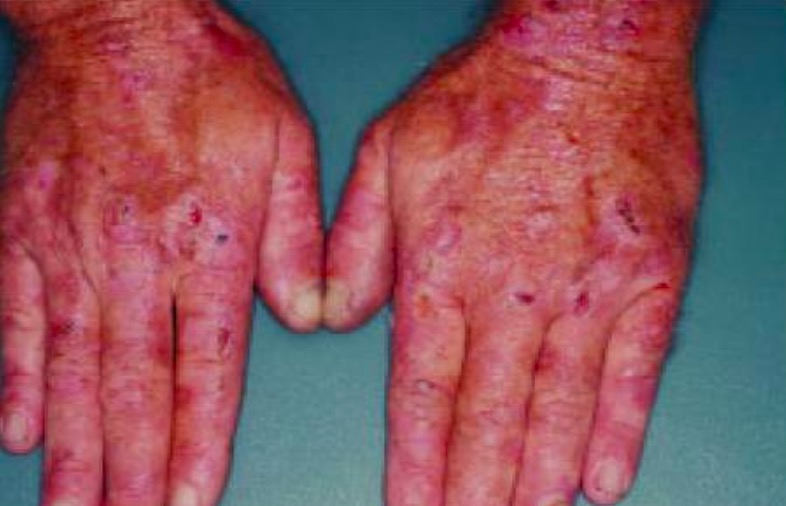Playlist
Show Playlist
Hide Playlist
Porphyria Cutanea Tarda
-
Slides Bullous Diseases.pdf
-
Reference List Dermatology.pdf
-
Download Lecture Overview
00:02 Now let's talk about porphyria cutanea tarda. 00:04 As I mentioned before, all the porphyrias are essentially derived or caused by a metabolic disorder due to the disruption of the normal heme biosynthesis pathways. And this is just a representative picture of the heme molecule. And there's a variety of steps that can occur along the way to creating a heme molecule. 00:23 There are both inherited and also acquired deficiencies in the pathways that lead to heme, and in this case, porphyria cutanea tarda involves an inherited or acquired deficiency of urogen decarboxylase. 00:37 Most common age of symptom onset is around 30-50 years of age, and flares can be precipitated at any time. 00:45 Oftentimes, by certain medications that a person ingests, alcohol has been shown to be a trigger, minor skin trauma, and then sun exposure, and that's why we'll oftentimes see these Patients who have this disease will complain of fragile skin, feeling pruritic, they may have brown hypermelanosis, vesicles can occur, bullae, and there can certainly be scarring after repeated flares over the span of many years. 01:17 As I mentioned, the face, the back of the hands, and there's also this predilection for hypertrichosis or increased hair development, particularly in areas of the face. 01:30 This is a representative lesion of some of the findings you may see in the skin.
About the Lecture
The lecture Porphyria Cutanea Tarda by Stephen Holt, MD, MS is from the course Allergic and Immune-mediated Skin Disorders.
Included Quiz Questions
What is the etiology of porphyria cutanea tarda?
- Deficiency in urogen decarboxylase
- Deficiency in porphobilinogen deaminase
- T-cell–mediated destruction of keratinocytes
- Autoantibodies to desmosomes
- Inflammation of subcutaneous fat tissue
Customer reviews
5,0 of 5 stars
| 5 Stars |
|
5 |
| 4 Stars |
|
0 |
| 3 Stars |
|
0 |
| 2 Stars |
|
0 |
| 1 Star |
|
0 |




